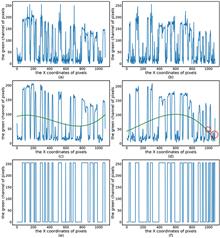To fully describe the structure information of the point cloud when the LIDAR-object distance is long, a joint global and local feature (JGLF) descriptor is constructed. Compared with five typical descriptors, the object recognition rate of JGLF is higher when the LIDAR-object distances change. Under the situation that airborne LIDAR is getting close to the object, the particle filtering (PF) algorithm is used as the tracking frame. Particle weight is updated by comparing the difference between JGLFs to track the object. It is verified that the proposed algorithm performs 13.95% more accurately and stably than the basic PF algorithm.
In order to improve the signal-to-noise ratio and mitigate the damage of noise to the communication quality, an effective interference suppression algorithm, which is based on the improved density-based spatial clustering of applications with noise algorithms, is proposed for visible light communication systems using the complementary metal–oxide–semiconductor image sensor as the receiver. Experimental results show that the algorithm can learn the region where the payload data is located, filter out the noise data, and greatly decrease the interference. The effect of the algorithm is also studied through bit error ratio performance.











